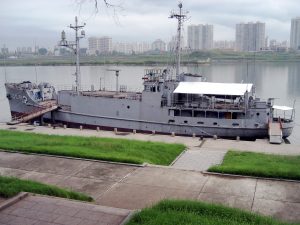[ad_1]
The Koreas | Politics | East Asia
Government-appointed “special master” says crew members suffered long-lasting aftereffects, both psychological and physical.

The spy ship USS Pueblo, captured in 1968, is now a museum in Pyongyang, North Korea.
Credit: Flickr/David Stanley
More than half-a-century after the USS Pueblo incident, a United States court has ordered North Korea to pay compensation totaling $2.3 billion to the crew and surviving families of the ill-fated warship for psychological and physical damages inflicted by Pyongyang’s interrogators.
The hermit-state is unlikely to pay the bill although it could be used as bargaining tool in any future negotiations and was only made possible by former President Donald Trump, whose administration declared North Korea a sponsor of terrorism in 2017.
That enabled a lawsuit to be brought in 2018 after the U.S. Justice Department ruled that, despite a law giving foreign governments broad immunity from suits in U.S. courts, they could be sued where a government is deemed a state sponsor of international terrorism.
“As a result of the barbarity inflicted by the North Koreans, almost all required medical and/or psychiatric intervention,” wrote Alan Balaran, the government-appointed “special master” in the case to decide on damages.
He said most suffered long-lasting aftereffects both psychological and physical.
“Many have undergone invasive surgical procedures to ameliorate the physical damage resulting from the relentless torture they underwent as prisoners,” he said in regards to the 82 crew who were taken as prisoners on January 23, 1968. One sailor was killed during the ship’s seizure.
Balaran added, “Several have attempted to numb their pain through alcohol and drugs, and most have seen their domestic and/or professional lives deteriorate. A few have contemplated suicide.”
The Pueblo, a spy ship dressed up as an environmental research vessel, was seized at the height of the Cold War amid claims it had illegally entered North Korean waters, a charge denied by the U.S. military, which insists the ship was always in international waters.
Adding to tensions was the war in Vietnam where American forces were gearing-up for a showdown at Khe Sanh against communist forces in the first half of 1968 following the Tet Offensive and attacks on the U.S. Embassy in Saigon.
That offensive proved a decisive public relations victory for communists seeking to turn public opinion in America against the war, and combined with the Pueblo incident, as once scribe put it, made the mighty U.S. look like a “helpless giant.”
The Washington Federal Court awarded surviving members of the crew and families of those now dead compensatory damages for confinement and suffering of $1.15 billion and that was doubled in punitive damages against Pyongyang.
Of that total damages of $22 million to $48 million were awarded to each of the 49 surviving crew members. About 100 family members were awarded smaller sums.
Survivors had long complained that their plight and almost a year in captivity had been ignored by the government and military establishment who they said had regarded them as an embarrassment.
“We were held for 11 months and beaten every day, humiliated, starved, just about anything you could think of,” Pueblo veteran Tom Massie told the Washington Post in an interview.
They were freed only after the U.S. officially apologized.
Some analysts have suggested the seizure emboldened then North Korean leader Kim Il Sung to adopt a much stronger, belligerent foreign policy towards Washington resulting in its nuclear and ballistic missile program.
It’s a policy that remains in force under his grandson and current leader Kim Jong Un and is an “urgent priority” under the new Biden administration.
The USS Pueblo is currently moored on the Pothong River in Pyongyang where it stands as a “victorious” museum but the vessel remains commissioned by the U.S. Navy as a ship held captive.
Luke Hunt can be followed on Twitter @lukeanthonyhunt
[ad_2]
Source link